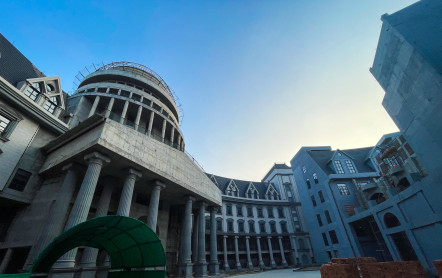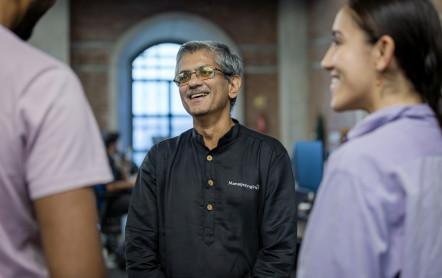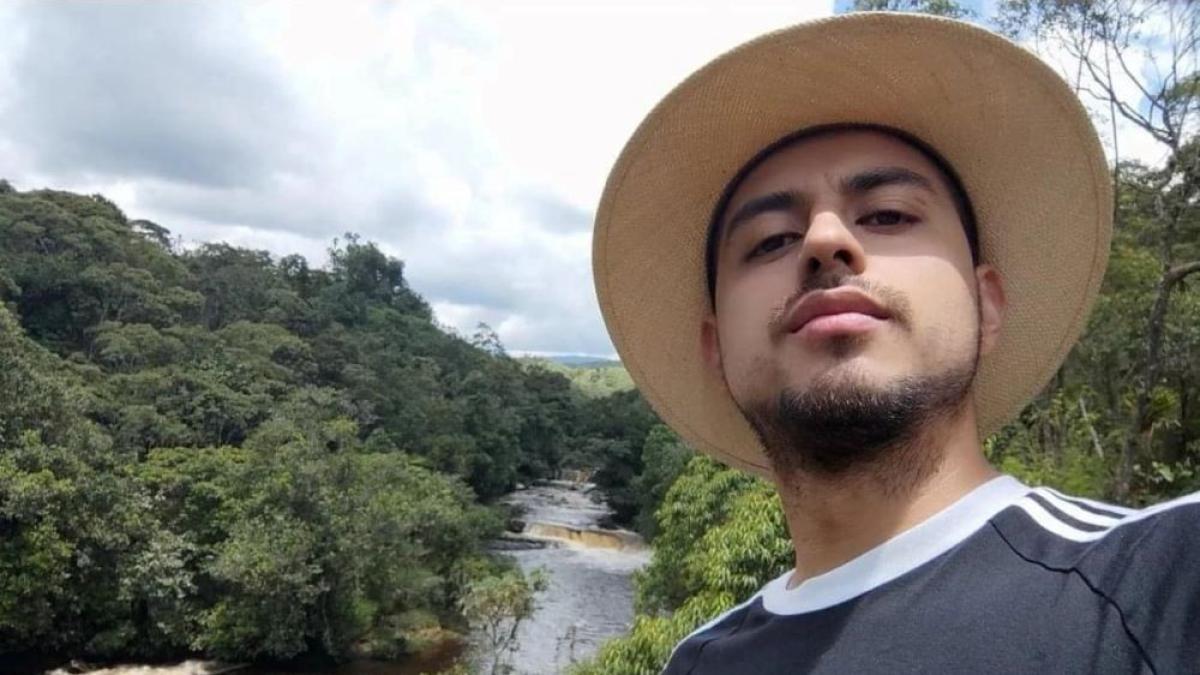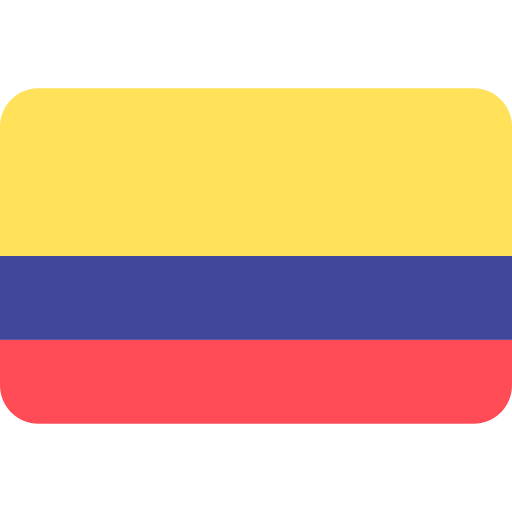¡Hola !, Tu correo ha sido verficado. Ahora puedes elegir los Boletines que quieras recibir con la mejor información.
Bienvenido , has creado tu cuenta en EL TIEMPO. Conoce y personaliza tu perfil.

El correo electrónico de verificación se enviará a
clementine@ejemplo.com
Revisa tu bandeja de entrada y si no, en tu carpeta de correo no deseado.
SI, ENVIAR
Ya tienes una cuenta vinculada a EL TIEMPO, por favor inicia sesión con ella y no te pierdas de todos los beneficios que tenemos para tí. Iniciar sesión
For a few weeks now, on several planes from Bogota to Cartagena and on the outside of the Rafael Núñez International Airport, there has been an advertisement that has caught the attention of travellers, especially because of its colours and unusual name.
It has a black background and four squares, each of a different colour: red, green, blue and yellow. The company behind it is Zoho Corporation, an Indian multinational founded in 1996 that specialises in developing software and applications for business.
The company has been dubbed the 'Google of India' because it is one of the most sought-after companies for internships and jobs for young university students, and because of the philosophy it has brought to the global IT market.
It is currently present in more than a dozen countries, including the United States, Japan and, for the past two years, Colombia, and employs around 15,000 people. Its products are used by more than 280,000 companies around the world, according to figures provided to this newspaper.
The company has two main divisions: Zoho, which offers a range of integrated platforms for customer relationship management (CRM), marketing, finance and more; and ManageEngine, which specialises in enterprise security, network and service management tools.
In 2022, it opened an office in Chia, on the outskirts of Bogotá (capital of Colombia), which has become its operational hub for Latin America, a market that is becoming increasingly important for the multinational. In the region alone, at least 5,000 companies use its products and it has 100 active employees.
EL TIEMPO has learned that Subin George, a senior manager at the Zoho Corp. operations centre in Chennai, in southern India, has been transferred to Bogotá to take up the post of regional director.
The arrival and expansion of an Indian multinational in Colombia has aroused the curiosity of several players in the IT sector in the country and the region. According to the Ministry of Trade, Industry and Tourism, there are around 75 Indian companies operating in Colombia.
This newspaper travelled to the company's central campus in Chennai - which is currently being expanded - to speak exclusively to Shailesh Kumar Davey, the new CEO of Zoho Corp, following the resignation of Sridhar Vembu, the company's founder and one of the country's tech giants.
How is the transition to the new CEO going?

Shailesh Kumar Davey, co-founder and new CEO of Indian multinational Zoho Corp.
Foto:Zoho Corporation
I'm taking it one step at a time. Sridhar Vembu has always been the face of the company. Over the last few weeks, we have been discussing everything related to artificial intelligence and how it will impact the business, how to implement the technology and how to take the next step. Sridhar has always been a very technical person and behind this change is a strategy to move to something beyond the visible face of a business. At the end of the day, customers buy a product because it is good, or because it gives them something of value, or because it gives them something to hold on to. For example, people can buy a Toyota car without knowing who the CEO of Toyota is. There are some companies that have a front, but there are many that don't, and they work just as well or better. Fortunately, we had Sridhar's face at the front, but now with this change in technology and the current landscape, we have to be much more focused to navigate a new point.
Will there be any changes to the structure of the company?
We have to focus on the technology. If you want to have focus and navigation, you need a good team. So responsibilities were assigned. The company has four heads, one based in the United States, one in charge of ZoHo, one in charge of ManageEngine, the company based in Colombia, and I will give direction to the whole company. From a branding perspective, these people have given the brand a reputation with certain customers. What we are going to do is spread the challenges of today's technology across all of them.
What will you focus on in the age of AI?
We have to look at what's relevant to the customer and what will help them do their job more effectively. And we want to make sure that those features are available in the product from a business perspective. We call it in-situ, meaning it's embedded in the product and it's very easy for the customer to use. When you talk about AI, there are four forms of models to understand: classic machine learning (ML), classic deep learning (DL), transformers and generative architectures. The first three have been around for a long time. What we are seeing today is a boom in content generation from commands and pattern training.

Zoho Corporation campus under construction in Chennai (India). The company employs 15,000 people.
Foto:David López. EL TIEMPO
Should we be worried about artificial intelligence?
You have to be aware of the speed at which AI is developing. If we could look back, we have already experienced similar moments. For example, imagine I am a car in 1890. The first cars were just appearing. As the "innovator car" of the time, I might have thought I had the market cornered. But then another model comes along with a more powerful engine and a revolution begins. This new car takes the lead, leads the way, and everything changes: the engine becomes the new standard of performance. Then came modern wheels, suspension, new designs and from then on the change was unstoppable. During this period there were a number of innovations that had never been seen before, and at the same time there was a growing conservative sector that opposed them. But in time, everyone adapted to the new reality. Every major technological change has followed a similar pattern. First there is scepticism, resistance, sometimes fear. The same thing happened with electricity, and there were those who said it could not be done, and much later with the internet and social networks. So there have been disruptions in the past and we as a human race have learnt from them, adapted to them and come out much better. When something becomes cheap and accessible, it starts to become ubiquitous and that creates even more value. The same thing happened with transistors: when they became cheap and accessible, they started to be everywhere, in washing machines, refrigerators, air conditioners, and with that came an explosion of value for people. Something similar happened with computers. At first there were fears of job losses, but then everyone had one and new opportunities were created. We are in a similar phase with AI. The difference is that this time we have a bit more time to adapt, to relearn. If we look at it from a historical perspective, humanity has been able to evolve with every major technological change. A curious fact: the time when there were more people on Earth is now, largely thanks to medical and technological advances. So the question is not whether AI will change the world, because it already is, but whether we will use this small window of opportunity to adapt well to change.
The question is not whether AI will change the world, because it already is, but whether we will use this small window of opportunity to adapt well to change
There are those who warn of job losses due to AI, what do you think?
An important factor is the context in which this takes place. Today, despite political differences, we live in a world where most countries have some degree of democracy. That means there is dialogue, debate and an active citizenry that participates and questions. And that, combined with technological progress, gives us a real opportunity to adapt in time. Ideas such as universal basic income are already being discussed, especially in a scenario where robots could take over much of the physical or repetitive work, such as in factories. If we get to a point where energy becomes almost free or infinite, as some have suggested could happen with advances in renewable energy, then the cost of producing many things could fall dramatically. It all comes down to how much energy it takes to make something. When that is no longer a constraint, the whole picture changes. I'm not saying it's going to happen just like that. But there are possibilities. And at the same time, there are still very real human needs: art, for example. If you have an orchestra, do you want to hear it played by robots or by real musicians? Or care for the elderly, which will become more and more necessary, who would you prefer? These are areas where empathy, creativity and human contact will continue to be key. And if we look at recent examples, users have already made up their minds. When Google came along, a new industry was born: SEO, SEM, digital marketing, jobs that nobody had imagined before. Something similar will happen with artificial intelligence. We are already starting to ask ourselves: how do we optimise a campaign so that it can be understood by an AI system? How do we communicate with a virtual assistant or an automated agent? It opens up new doors and new roles. Ultimately, I think it's a question of whether we have enough time to adapt. But I am confident. There is a conscious society with access to information and tools to manage this change. So we need to prepare and be creative. The only limit is our imagination.

DeepSeek, from China, topped the Apple Store download list one day after its launch in Q1 2025.
Foto:Nicolas TUCAT / AFP
Why has India not yet adopted a model like OpenAI in the US or DeepSeek in China?
We need to get it out there. And I think ideally it should be in an open source environment, as models of the calibre of ChatGPT and OpenAI or DeepSeek have done. In fact, the latter is setting a new precedent that will probably inspire many people and organisations around the world. China, for example, has a closed domestic market where they can quickly test large-scale models. India is different, but it doesn't have to be left behind. The conditions are there, and I'm sure there are already many, many people thinking about how to build local, competitive models. It's just a matter of time.
Do you develop your own AI models?
It is important to have a good understanding of the value of these models. Not just the results they produce, which are visible, but also how they were built, what data they were trained on, what kind of infrastructure was used, how many resources such as GPUs (graphics processing units) were used. All of that matters. And that's where strategic thinking comes in. If you look at the evolution of technology services globally, for years it was: if it was hardware, you went to China; if it was software, you went to India. That took decades to build, and today India has a solid talent base with decades of experience. There are a lot of global centres of excellence here, and that's a big advantage. Now, with the advent of generative AI, a lot of people are focusing on how to apply these models to real business problems. ISVs (independent software vendors) are working on that. But with examples like DeepSeek, it's natural for many to ask if they can build their own models at a lower cost. And that's exactly what we're doing. We've been training our own models from scratch for six months. We want to get a good understanding of what this monster is, how it trains, how it adapts. But that takes time.
The conditions are there, and I'm sure there are already many, many people thinking about how to build local, competitive models
What is this strategy based on?

Women workers at Zoho Corporation in Chennai (India)
Foto:David López. EL TIEMPO
Our strategy is two-pronged. One is to use what we already have to deliver value quickly, and the other is to invest in research and development to improve our own capabilities, train our own models and understand how to make them useful. Both lines of work continue in parallel, one solving today's use cases, the other preparing for the future. We have rejected Silicon Valley trends to build our own products. Our focus is on building a thousand fast ships in different directions, not one giant ship.
Could you elaborate on that last point?
Our strategy is based on not putting all our eggs in one basket. Instead of building one big ship, which can take years to develop, requires a large investment and is difficult to manoeuvre when the market changes, we prefer to launch many small, fast ships. The idea is simple: have several small teams developing different products at the same time. Some of these products will work very well, others less so. The important thing to understand is that the market acts like a natural selection system: products that don't work are quickly discarded and resources are redirected to those that do. This approach reduces risk because we are not dependent on any one big bet. Small teams also have a big advantage: they can adapt much more quickly to market changes. Today we have more than 50 active products, and although they were born as individual solutions, they all share the same technological base. Nothing has been bought, everything has been built in-house, on our own engineering platforms. This allows us to easily integrate them and offer complete solutions to the customer as a single cohesive platform. In short, we prefer to build many small, fast and agile vessels rather than one big one. One big ship can go a long way, but when it needs to turn, it's slow. With many small ships, we have more options, more flexibility and more speed to adapt to change.
Our focus is on building a thousand fast ships in different directions, not one giant ship

Shailesh Kumar Davey, co-founder and new CEO of Zoho Corp. The multinational company has over 120 million users globally.; for many it is the 'Google' of India.
Foto:Zoho Corporation
Let's talk about leadership. More than 20 CEOs of large multinational technology companies are from India. You are taking over as CEO of a company with more than 15,000 employees. What makes Indian workers rise to the top of companies at this level?
There is a certain bias when we talk about technology leadership, especially in the US context. Many of the Indian leaders we see there today are part of the top one per cent of talent in the country. If you look at the CEOs of large technology companies, most of them come from some of the top universities in India. Even from there, there is a very strong selection process. Typically, they do their undergraduate education here and then go to the United States to do postgraduate work at institutions that have huge resources for research and development. There they join a much more productive ecosystem, with more funding, more infrastructure and an environment that encourages innovation. And because they were already part of the one per cent here, they would also stand out there. They would be at the top of any country, the US, China, Russia, wherever. But beyond academics, there are cultural factors that come into play. I think Indians tend to be good philosophers, in the sense that we think a lot, debate a lot and have the ability to live with opposing ideas without getting confused. This mental flexibility is very helpful in leadership. There is also usually a more humble, empathetic leadership style. Most of these leaders know how to listen, integrate different points of view and make decisions that are more inclusive. This makes teamwork and collaboration much easier. Ultimately, I think it's a combination of academic merit, global exposure and a cultural approach that values both deep thinking and human connection. And all of that translates into leadership that scales. That's why we see so many Indian professionals rising to the top of the tech industry.
I think Indians tend to be good philosophers
What do you see as the main challenges in educating the new generations?
We always hear criticism of young people and the current education system, as if the new generations are not up to the task. But I think this is nothing new. If you read Aristotle, more than two thousand years ago, he complained that the young people of his time were not like the young people of his time. And yet the world has moved on. I am an optimist by nature. Every generation faces its own challenges, and although it sometimes seems unprepared, history shows us that humanity has always found ways to adapt. We continue to move forward as a society, as an economy, as a civilisation. We have survived world wars, pandemics, economic crises, geopolitical conflicts, and we are still here. Even recently, when a third world war seemed imminent, we saw how diplomacy, however imperfect, prevented things from escalating further. No atomic bomb has been used since Hiroshima and Nagasaki. That in itself is a sign of collective learning. So when we talk about the education system and young people, it is clear that there are things that need to be improved, that the system needs to evolve, to adapt to the digital world, to new ways of thinking, to a changing environment. But I am confident that it will. And that young people, as always, will find their way. Because at the end of the day, the world is moving on. What we need is sensitivity, awareness and a willingness to adapt.

Subin George, Director for Latin America and Iberia at ManageEngine
Foto:ManageEngine
What is your presence in Colombia and Latin America?
Latin America is one of our fastest growing markets. In countries like Mexico, Argentina and Chile, we are very focused, with a local team of almost 90 people and a real presence on the ground. In Colombia we have about 80 people just for ManageEngine.
Other tech giants like Google and Amazon are popular in Latin America, what makes them different from you in terms of breaking through in the region?
We have a pretty broad portfolio of tools that cover a lot of areas. If you think about companies like Google, for example, they have solutions like Gmail, Search and Google Workspace, but they don't have as deep coverage in business functions or IT management. We work with the philosophy of a thousand speedboats: we develop many specialised products, each focused on a specific need.
And they are all consumed? You'd think there would be a margin of error, as there is in several companies....
Most of them find users who appreciate and use them. One of our great strengths is our focus on mature products. We invest much more in research and development and less in marketing than many companies do today. Because we are not a public company, we are not subject to short-term pressures. We can make decisions for the long term, which allows us to build with more solidity and less external noise. For example, many of our partners have worked with us for over 15 years. They know our capabilities, our limitations and they trust what we promise our customers. Of course we have business targets, but if we don't meet a certain target, there is no immediate penalty from the market. We can stop, analyse what went wrong, whether it was a strategy or a poorly communicated message, and adjust. This gives us an agility and capacity for continuous improvement that is difficult to achieve under market pressure. And all of this together gives us a unique competitive advantage. It's not just the technology, or just the business model, or just the fact that we're not public: it's how all these elements come together to create a differentiating proposition.
You have chosen to expand to the other side of the world, to the American continent, which has its own peculiarities, with Donald Trump back in the White House in the United States, Nicolás Maduro still in Venezuela and a left-wing president for the first time in Colombia. How do you manage to adapt to these political changes, which have a constant impact on the economy?
Latin America is very different from other regions, such as Asia, and requires a flexible and open-minded approach. We understand the local context. In countries such as Argentina, where the currency fluctuates constantly and there are multiple exchange rates — such as the official dollar and the 'blue dollar' — adaptability is paramount. As a private company, we have the freedom to work closely with our partners, understand their situation, and find creative solutions. Sometimes, a client may not be able to pay in dollars directly, but may be willing to negotiate in another way. We've even heard, 'I can't pay you in dollars, but I can pay you in coffee.' While this may sound unusual, if the offer has value, we will accept it and trade it in another market to generate income. Such agreements would not be possible in a public company, where every transaction must conform to strict regulations, and any atypical movement would be scrutinised by the market and shareholders. Instead, we should use our common sense, maintain close relationships with our partners and ensure that business arrangements benefit both sides. Naturally, there are limits; for example, we cannot operate in countries such as Syria for legal or ethical reasons. However, outside of these cases, we are always willing to listen and find ways to collaborate that work for both parties. Our ability to adapt is one of our greatest strengths in markets such as those in Latin America, and we intend to continue using it to build long-term, pragmatic, trust-based relationships.
DAVID ALEJANDRO LÓPEZ BERMÚDEZ
EL TIEMPO Special Envoy to Chennai (India)
Journalist of Special Multimedia Content
berdav@eltiempo.com
html:
Read more content in English:
Conforme a los criterios de


.png) hace 2 semanas
115
hace 2 semanas
115








 English (US) ·
English (US) ·  Spanish (CO) ·
Spanish (CO) ·